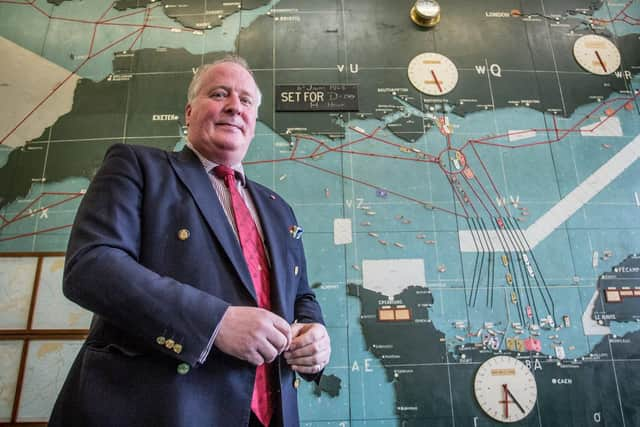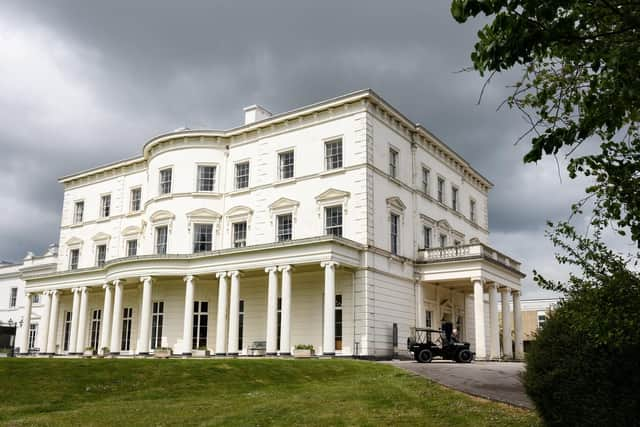How D-Day was planned at Southwick House


In the most fraught moments of the Second World War, this quaint English country house hosted one of the fiercest debates of the war – on the quintessentially English subject of the weather.
According to historian and retired Colonel Jeremy Green, the weather underpinned ‘the key decision' to postpone D-Day, made by General Dwight Eisenhower in the library room of Southwick House.
Advertisement
Hide AdAdvertisement
Hide AdLaunching more than 4,000 vessels and 11,000 aircraft to carry 154,000 troops to liberate Europe required nothing less than optimal conditions.


Jeremy says: 'The problem was a huge divide in opinion between British and American meteorologists
‘The Yanks were saying the weather looked good for June 5.
‘The Brits were saying, ‘”no it’s not – it’s our weather, you can’t work our weather out”.’
The invasion was planned to begin in just four days time.


The debate between the two teams raged while the highest ranking generals of the Allied forces waited for the weather forecast, causing the lead British meteorologist Dr James Stagg, to say: ‘Had it not been fraught with such potential tragedy the whole business would have been ridiculous.’
Advertisement
Hide AdAdvertisement
Hide AdStagg, a polar explorer and geophysicist, addressed the generals in the library on June 2, announcing the weather 'was full of menace.'
Jeremy says: ‘The generals looked out at a beautiful English summer evening.
‘In fact, their staff was playing cricket outside, boys versus girls.’
The next day, with no improvement in forecast, General Eisenhower was forced to accept a day's postponement.
Advertisement
Hide AdAdvertisement
Hide AdHe wrote in his diary: ‘Probably no one who does not have to bear the direct responsibility of making the final decision as to what we should do can understand the intensity of this burden.’
June 4 brought a different type of black cloud - as Southwick House saw the arrival of exiled French military leader, Charles De Gaulle who reportedly had a ‘face like thunder’ over the handling of the operation.
Jeremy says the French commander ‘harangued' Eisenhower for more than two hours, angry at everything from the postponement to the wording of the 'invasion' of occupied France.
He adds: ‘Eisenhower was a master diplomatist.
‘So he takes De Gaulle for a walk and a smoke in the gardens of the house.'
Advertisement
Hide AdAdvertisement
Hide AdThat evening Stagg made the announcement of 'rapid and unexpected developments' meaning favourable weather on Tuesday June 6.
Eisenhower made the decision to launch the invasion on that day in the library room of Southwick House.
He then travelled to South Parade Pier to see the last troops embarking, before returning to his trailer hidden under camouflage nets in Southwick Park, where he reportedly played a much simpler game of strategy – checkers.
A local legend claims that Eisenhower and General Montogomery would relive stress during their time in Southwick by shooting at a tree on the grounds – which a foreseter discovered riddled with bullets decades later.
Advertisement
Hide AdAdvertisement
Hide AdJeremy says the significance of events has created countless tall-tales wherever the historic figures stayed.
He says: ‘There are a lot of apocryphal stories about him going to local pubs in Portsmouth and discussing D-Day.
‘For one, the man is so busy.’
‘And he's not going to discuss the biggest secret of the war in a Portsmouth pub where there could be a German spy.'
He adds: ‘I must have meet 200 of Winston Churchill’s supposed bodyguards in my time.’
Advertisement
Hide AdAdvertisement
Hide AdAside from some embellishments, Portsmouth’s role is 'clear in the D-Day story,' according to the local historian
The invasion saw a massive operation involving hundreds of members of staff across Hampshire.
Switchboard operators - some just having turned 18 - worked deep underground at Fort Southwick to relay messages from the beaches of Normandy to the generals in the map room of Southwick House.
The huge number of ships and aircraft were represented on a giant wall sized map in the house itself, with plotters working long hours to ensure the generals could see the vast armada moving into position in close to real time.
Advertisement
Hide AdAdvertisement
Hide AdThe toy manufacturer Chad Valley had been commissioned to make the large ply wood wall map, which arrived in section and was put together by two carpenters.
The pair completed their task within a few days in April, but did not leave until September – they were detained in Southwick to maintain secrecy until the invasion was well underway.
Jeremy says: ‘It's central here - it's home of the navy, you have Fort Southwick, the underground HQ for Operation Neptune, and you have Southwick House.
‘Portsmouth underrates itself.'
Jeremy believes between 'the Hollywood image' and the logistics of the operation, it is easy to 'forget war is awful.'
He explains: 'The losses sustained were huge.
Advertisement
Hide AdAdvertisement
Hide Ad'Because of that there was a whole generation of vets who never mentioned it when they came home.
'Their medals went in a draw and that was it - job done.
'It was a dirty job, but it had to be done.'
On the evening of June 4 1944, a figure could be seen on the ridge of Portsdown Hill.
The man was taking in the view of Portsmouth and the armada of vessels in port and just out to sea, full of troops waiting to land in Normandy, where one in two were expected to be killed, injured, or captured.
It was the only moment when the man on the ridge, General Eisenhower, was seen by an aid to be emotionally affected by the operation.
Jeremy says: ‘In that quiet moment, he must have thought – ‘what have I done?''